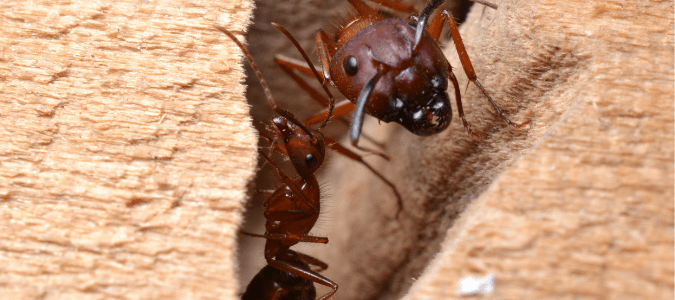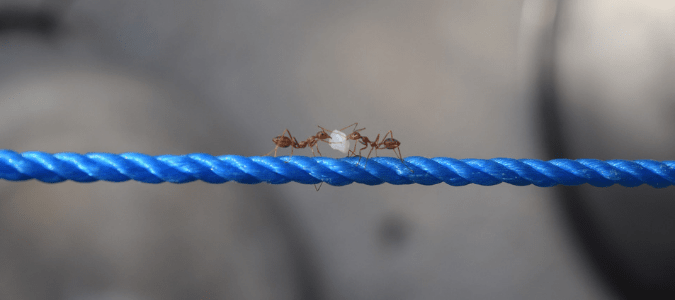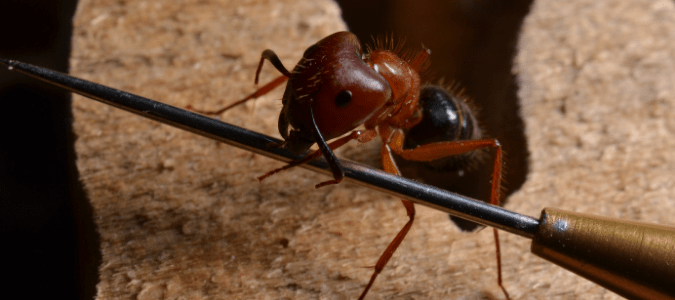Carpenter ants are a common pest throughout the southern United States, including Texas. Typically, they make their first appearances as the weather begins to turn in late winter. As early spring brings warmer weather, they begin their mating cycle and establish new colonies.
Identification
Carpenter ants, which are pictured above, are one of the larger of the 18 species of ants found in Texas. On average, they are one-quarter to three-eights of an inch in length. Their head is rusty, reddish-brown and their thorax leads to a black body and tail. The flying version of the species is often all black, and can easily be mistaken for termites. To make matters more confusing, they often swarm at the same time. On the other hand, the average worker ants can range in appearance from brownish-yellow to black. Swarmers are most prolific between February and June in Southern areas of the United States. An average mature colony of Texas carpenter ants can contain upwards of 20,000 workers. However, large colonies can expand to as many as 50,000 ants.
Diet
Carpenters, like most species of ants, are omnivorous. These ants eat both insects and plants. Their diet includes fruits, plant juices, sweets, red or white meats, fats or grease, and even other insect species. Ironically, the carpenter ant’s digestive system is unable to process cellulose, so they can’t eat wood or wood-related plants. Feeding mostly at night (though opportunistic enough not to pass up an easy meal in the daylight) they will tend to forage along linear pathways like the edges of garden plots, foundations, hose lines and, of course, along the edges of your home’s floorboards.
Nesting
Carpenter ants aren’t extremely picky when it comes to choosing colony locations. Their preferred nesting sites include anything from trees and stumps to hollow-core doors, attic insulation or cardboard boxes. Most locations, whether indoor or outdoor, will share one commonality, however…a nearby source of moisture.
One sure way to identify that a carpenter ant nest is in the vicinity is the presence of small mounds sawdust, wood shavings, or other debris, referred to as “frass”. Frass is made up of the discards of their nesting excavations and their excrement. These tell-tale little piles of sawdust leavings are what gave carpenter ants their name to begin with. Behind these frass mounds are small holes that lead to the nesting chamber, as digging these tunnels is what creates the frass.
Other preferred nesting locations can include:
- Wet wood resulting from draining gutters, window or roof leaks, or pipe seepage.
- Seepage areas around kitchen, bathroom or utility plumbing and nearby cabinetry or appliances.
- Gaps between ceilings and roofs, especially in outdoor locations like porches.
- Wooden areas that are weak due to condensation, like attics, crawl spaces or cellars in homes or outbuildings.
- Any gaps in bathroom or kitchen insulation, both roll-out and rigid foam board.
- Gaps behind exterior doors or window frames.
Life Cycle
Carpenter larvae will grow and pupate into adult worker ants within one to two months. They then begin to expand the nest, dig new tunnels and galleries, and begin collecting food for their queen and new generations.
Damage
Carpenter ants who nest and forage in the outdoors are not considered to be particularly serious pests. It’s when a colony finds comfortable quarters inside homes that they begin causing serious trouble. A home infestation, besides being visually unpleasant, can lead to dire and expensive damage to both structure and property, unsanitary living conditions, and is a sure sign of bigger ownership issues like wood rot, water damage, and other structural issues.
Also, given that they are wood-destroying insects, the presence of carpenter ants can be reported during real estate transactions and can reflect poorly on the resale value of a home or property. This is why professional pest treatment for carpenter ants is important.
Sugar Ants Versus Carpenter Ants
Identifying different ant species in Texas can be tricky. Another commonly found pest in Texas, and most of the rest of the country, is the Pharoah ant, which is pictured above. Also called sugar ants or piss ants, this species is also omnivorous, though historically shows an affinity for sweets. They are the bane of kitchens and kitchen workers everywhere.
At just one-twelfth to one-sixteenth of an inch long, they are significantly smaller than their carpenter cousins. Sugar ant nests are usually in small spaces, such as wall cracks and light sockets. As long as it includes a source of moisture and warmth, sugar ants will happily nest there. They also tend to be more uniform in color, with solid color bodies ranging from reddish-yellow to gold.
While carpenter ants can bite, they don’t carry any pathogens. On the other hand, Pharoah ants carry a wide variety of pathogens and bacteria, including salmonella, staphylococcus and clostridium, but they won’t sting or bite.
What Causes Carpenter Ants?
There are a number of things that can attract carpenter ants to your home or property, but the big three are moisture, access to food and clutter.
Moisture
Carpenter ants seek out warm, damp areas, especially those hiding spots that include soft or rotting wood, making their excavation habits even easier. Kitchens, bathrooms and laundry areas are often ant-friendly locations. Spots with leaking pipes or other water seepage are a major attraction, as well. Fixing pipes, sealing up areas of seepage, and adding ventilation to help keep trouble areas dry are key to making your home inhospitable to carpenter ants.
Access to Food
Like all pests, ants are constantly on the hunt for food, and locations that provide an easy meal are sure to attract them. Unsealed garbage cans, kitchen clutter and spills (especially anything sticky, sweet or high in protein), and accessible pet food containers make for common and popular ant buffets. Lawn and garden areas with a high population of aphids (a favorite ant snack) can ring the dinner bell as well. Since ants prefer to forage at night, an evening clean-up regimen, including sealing all open containers both inside and outside, can help send carpenter ants looking elsewhere for their next meal.
Clutter
Piles of trash, stacks of old firewood or lumber (especially in damp areas) are another welcome sign for ant colonies seeking shelter. Infested firewood can be a quick and unnoticed means of bringing outdoor pests into your home, where they will quickly seek to establish new living quarters. Cluttered garages and sheds can host massive colonies that will split off each spring to establish new nests both indoors and outdoors. Sealing these areas tight enough to prevent access by an ant can be almost impossible.
Your best bet, once the pests are controlled, is to keep them organized and clutter-free to discourage infestation.
Control
Managing carpenter ants can feel like an unending battle for the average homeowner. Thorough inspections and training in what to look for and where to look are vital in finding the colony on your property or in your home. Not to mention, it can be difficult to differentiate between carpenter ant damage and termite damage.
Once ants are dealt with, some steps must be taken by the homeowner to lessen the chances of reinfestation. Preventative steps include:
- Keeping stacks of firewood (a prime nesting area) a safe distance from buildings and foundations to discourage migration, and avoid keeping firewood stored inside garages, mudrooms, or other locations with easy access to the home.
- Repairing foundations by sealing all cracks and openings, especially those that allow access to the interior of the building from the outside, like pipes or electrical conduits.
- Fixing any moisture problems like leaky roofs, gutters, drain, or plumbing leaks that will attract new ants.
- Trimming bushes, tree limbs, or any other vegetation that can tough your siding or roof, creating a bridge for carpenter ants seeking food or new nesting locations.
If you suspect a carpenter ant infestation on your property, your best chance of ridding yourself of these pests is to contact a licensed and experienced pest control professional. These professionals can quickly assess your situation and make determinations as to the extent and locations of infestation, as well as offer you the best possible solution plan for your particular situation.
Not only is a professional better prepared to evaluate your pest problem, but they also have access to the tools and products that are best suited to get the job done. These materials often require a license to obtain and are unavailable to home and property owners.
ABC Can Treat the Carpenter Ants on Your Property
If you’re dealing with carpenter ants, contact ABC Home & Commercial Services. Our professionals will create a custom pest treatment plan for your property. We even offer preventative pest control services, so any potential pest problems will be stopped in their tracks.



